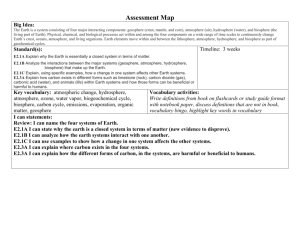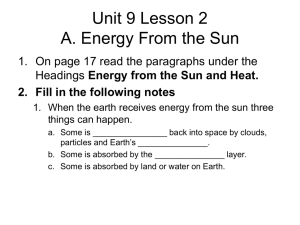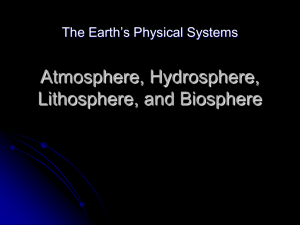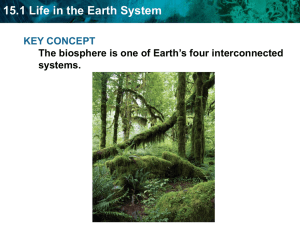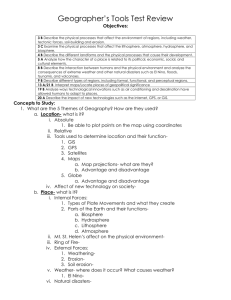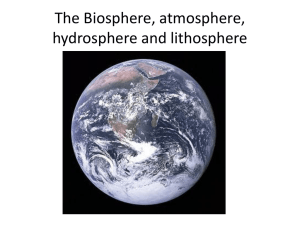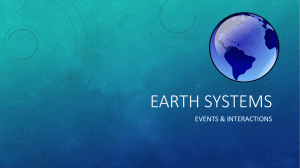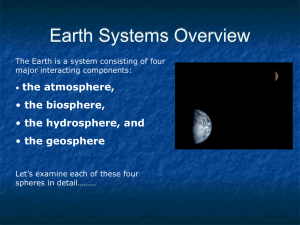Survivor: Earth Lesson Plan
advertisement
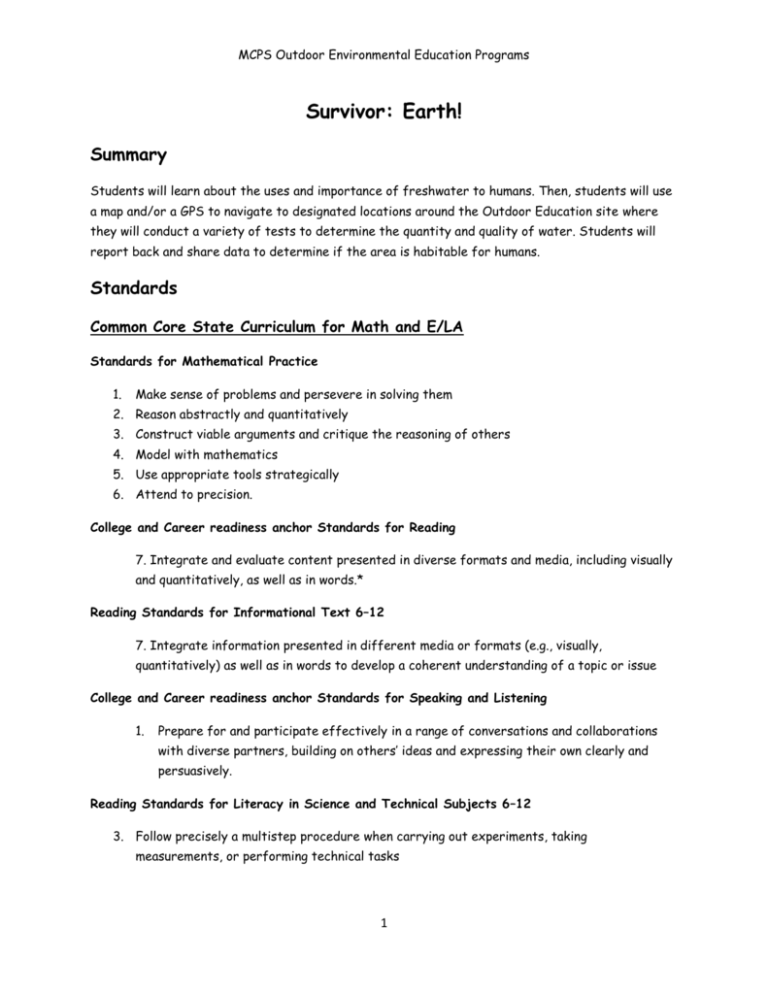
MCPS Outdoor Environmental Education Programs Survivor: Earth! Summary Students will learn about the uses and importance of freshwater to humans. Then, students will use a map and/or a GPS to navigate to designated locations around the Outdoor Education site where they will conduct a variety of tests to determine the quantity and quality of water. Students will report back and share data to determine if the area is habitable for humans. Standards Common Core State Curriculum for Math and E/LA Standards for Mathematical Practice 1. Make sense of problems and persevere in solving them 2. Reason abstractly and quantitatively 3. Construct viable arguments and critique the reasoning of others 4. Model with mathematics 5. Use appropriate tools strategically 6. Attend to precision. College and Career readiness anchor Standards for Reading 7. Integrate and evaluate content presented in diverse formats and media, including visually and quantitatively, as well as in words.* Reading Standards for Informational Text 6–12 7. Integrate information presented in different media or formats (e.g., visually, quantitatively) as well as in words to develop a coherent understanding of a topic or issue College and Career readiness anchor Standards for Speaking and Listening 1. Prepare for and participate effectively in a range of conversations and collaborations with diverse partners, building on others’ ideas and expressing their own clearly and persuasively. Reading Standards for Literacy in Science and Technical Subjects 6–12 3. Follow precisely a multistep procedure when carrying out experiments, taking measurements, or performing technical tasks 1 MCPS Outdoor Environmental Education Programs 7. Integrate quantitative or technical information expressed in words in a text with a version of that information expressed visually (e.g., in a flowchart, diagram, model, graph, or table) Next Generation Science Standards ESS2.C: Water continually cycles among the land, ocean, and atmosphere via transpiration, evaporation, condensation, precipitation, and the downhill runoff on land. Global movements of water and changes in its chemical phase are driven by sunlight and gravity. ESS3.A: Humans depend on Earth’s ocean, atmosphere and biosphere for many different resources. Fresh water and biosphere resources are limited, and many are not renewable or replaceable over human lifetimes. These resources are distributed unevenly around the planet as a result of weather-and climate-related processes. ESS3.C Humans have become one of the most significant agents of change in the nearsurface Earth system. Human activities have significantly altered the biosphere, geosphere, hydrosphere, and atmosphere. As human populations and per-capita consumption of natural resources increase, so do the impacts on Earth’s systems unless the activities and technologies involved are engineered otherwise. Continued monitoring of the changes to Earth’s surface provides a deeper understanding of the way in which human activities are impacting the Earth’s systems, providing the basis for social policies and regulations that can reduce these impacts. NASA’s Global Precipitation Measurement (GPM) Mission: GPM helps monitor inputs into the Earth’s water cycle. All life relies on the availability of water. Knowing when, where, and how much it rains or snows is vital to understanding how weather and climate impact our environment and the Earth’s entire water and energy cycle, including effects on agriculture, freshwater availability, and responses to natural disasters. Enduring Understandings: Water is found almost everywhere on Earth but only a tiny fraction of the water is available for human consumption. All life relies on the availability of water. Knowing when, where, and how much it rains or snows is vital to understanding freshwater availability and how water cycles through then environment. 2 MCPS Outdoor Environmental Education Programs Human use of natural resources can cause changes that have social, economic, and environmental impacts. Essential Questions: Where do we find freshwater in the natural environment? How do we measure freshwater availability? How do humans depend on and impact Earth’s limited supply of freshwater? Mastery Objectives Students will be able to: Describe components of the water cycle. Explain ways to measure water availability in the natural environment. Use a map and/or a hand-held GPS to navigate to predetermined locations. Describe the ways humans use Earth’s freshwater supply and how we can conserve it. Vocabulary Atmosphere, hydrosphere, geosphere, biosphere, global positioning system (GPS), precipitation, navigation, water cycle Materials GPS Units/Maps Pencils Engage video/presentation Data sheets Weather Station Backpacks with supplies: Thermometer Soil moisture probe Pencils Land Classification Key 3 Collection jar Spoon pH strips MCPS Outdoor Environmental Education Programs Engage (10-15 minutes) Engage the students by presenting the scenario and their mission. Use the powerpoint 1. Show message from the future. 2. What did we learn from this message? Which of your actions affect the environment and what are some of the effects or consequences? Resources are becoming scarce (electricity, food, water, paper). Humans wasting and abusing them has resulted in a shortage of these resources. 3. What should we do? Paper, electricity, food, water… all are based on ONE resource that we should study… WATER!! 4. Your mission, which you have no choice but to accept, is to visit many locations, conduct tests in all parts of the ecosystem, collect data to report to the group, and decide if this place is habitable to humans or not. 5. Review the water cycle and the locations of the four “spheres” to study and the interactions between the spheres. Explore In the classroom (30 minutes) 1. Divide students into groups of 6. Each student will be an expert in one category (Atmosphere, Biosphere, Hydrosphere, Geosphere, Chief Scientist and Navigation) – students can choose or the teacher can assign roles. Although one person is the “expert” for each category, the entire group will assist at all locations. If group has only 5 students, one student can be both Navigator and Chief Scientist. 2. Pass out data sheets and student instructions to each group. They should write names in to designate the expert for each data collection topic. If desired, ask students to complete the attendance strip and collect it so you know who is in which group. 3. Review the roles and categories of data collection with the students: Atmosphere, Biosphere, Hydrosphere, Geosphere, Chief Scientist and Navigation. Each category has an expert who will read the instructions and record the data, but the whole group will participate in the testing and data collection. 4. Pass out the backpacks with equipment. Give students time to review their expert cards and equipment and ask questions about how to conduct their test and collect their data. If time, ask each expert to summarize their task to the rest of the group. Demonstrate any tests 4 MCPS Outdoor Environmental Education Programs for the students. Remind them to be respectful of the materials – don’t lose or break the equipment. 5. Review navigation techniques with students – either using a map or teach students how to use the GPS and find their waypoints. 6. Review safety reminders and helpful hints (with the teacher map). 7. Ask the students to write the time to return (at least 15 minutes before the instructional session ends). Outdoor Exploration – as a class (15 minutes) 8. Visit the first location together to practice with the map, GPS (if used) and data sheets. Remember: although one person is the expert in charge at each location, the entire team helps collect the data. Outdoor Exploration - Group Data Collection (+/- 45 minutes) 9. Students will travel to their assigned locations in the order given. They will all visit the weather station/atmosphere together and then navigate to one other location assigned. They will complete all other tests at this location. If they can’t find the exact location, they can conduct the tests anywhere! 10. As they go, groups will collect data and tally their points to report back to the class. The data collection areas are as follows: a. Atmosphere: rainfall, temperature, clouds b. Geosphere: soil temperature, moisture, consistence, and color c. Biosphere – land cover classification d. Hydrosphere – water temperature, transparency, and pH Explain 1. First, students should total up their points for each data category then make a grand total. Have them write this number on a sticky note and post the sticky note on the map in the area they explored. The maximum number of points possible is 100. 2. If there is time, they can also write points for specific tests of your choice, like soil moisture or land cover. 3. Summarize - is this area is habitable or not? What were some unique observations they made? What were some challenges they had along the way? 4. Why does this matter? Discuss actions they can take to conserve water to prevent this situation from ever happening. 5 MCPS Outdoor Environmental Education Programs Evaluate Students should complete the exit card and turn them in to the teachers. Students can also complete the journal page to show what they’ve learned. Extend Conduct these tests/observations back at school and compare this data with data from your schoolyard. Research precipitation data on the GLOBE website – compare our area to other places around the world. http://globe.gov/ Share water conservation strategies with others at school, at home, or in your community. 6

